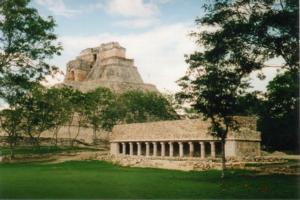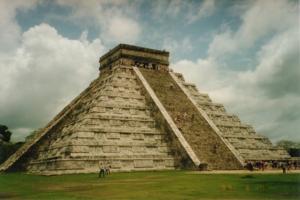
The longest lasting of the Maya cities, flourished 455 - 692 and 987 -1441.
Chichén Itzá is located in an arid region next to two sinkholes in limestone formations, from which two wells delivered water (hence the city's name chi ("mouths") and chen ("wells"). It had a population of about 200,000 people.
Chichén was founded in 455. The buildings in the "Old City" (Chichén Viejo) stem from the Old Empire period; they include the observatory El Caracol ("The Snail"). After the collapse of the Maya cities of the southern lowlands Chichén was reoccupied in the 10th century by foreigners, possibly the Itzá who gave the city its full name.
The "New City" (Chichén Nuevo) displays several images of the god Kukulcán, the plumed serpent known to the Toltecs as Quetzalcoatl, another sign for new influences in Maya society.
In 1998 Chichén Itzá was designated a UNESCO World Heritage site.

The main plaza of the city had on one side the public market, on the opposite side a building with a row of columns and between them the public steam bath. The photo shows part of the plaza, known as the "Plaza of the Thousand Columns." In the background is the "Temple of the Warriors."

The pyramid of Kukulcán known as "The Castle" was built on a smaller earlier structure. Two of its four sides have been restored. Originally each side had 91 steps, and with the addition of the platform at the top there are 365 steps, one for each day of the year.

The Observatory, known as El Caracol ("The Snail"), was constructed during the Old Empire. It consists of a tower built on two older platforms. Several small windows allowed astronomical observations. A circular stairway resembling a snail shell leads to the highest part of the tower. The tower is about 13 meters tall, and the observatory measures 22.5 meters in height.
http://www.internet-at-work.com/hos_mcgrane/chichen
(accessed 28 January 2004) Photographs by L.Swanson